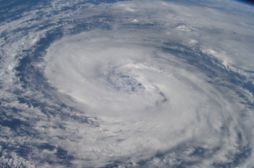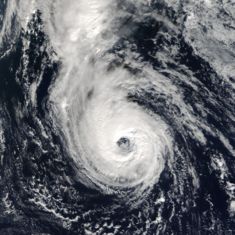Hurricane Epsilon (2005)
2008/9 Schools Wikipedia Selection. Related subjects: Natural Disasters
| Category 1 hurricane ( SSHS) | ||
|---|---|---|
|
Hurricane Epsilon gathering strength when this image was acquired on December 4, 2005 |
||
| Formed | November 29, 2005 | |
| Dissipated | December 8, 2005 | |
| Highest winds |
|
|
| Lowest pressure | 981 mbar ( hPa; 28.98 inHg) | |
| Fatalities | None reported | |
| Damage | None | |
| Areas affected |
No land areas | |
| Part of the 2005 Atlantic hurricane season |
||
Hurricane Epsilon was a long lasting hurricane of the 2005 Atlantic hurricane season in late November and early December over the central Atlantic. Hurricane Epsilon was the twenty-seventh tropical or subtropical storm and the fifteenth hurricane of the season and was one of the strongest Atlantic hurricanes ever recorded so late in the year.
Hurricane Epsilon developed from an extratropical storm on November 29 and gradually developed into a hurricane on December 2, despite a highly hostile environment. Epsilon then held onto hurricane status for several more days, despite all predictions by the National Hurricane Centre, before finally dissipating on December 8.
Storm history
Hurricane Epsilon developed out of an extratropical storm in the central Atlantic Ocean on November 29 that had gradually gained tropical characteristics in the wake of Tropical Storm Delta. It was well east of Bermuda at the time and never would get close to land. Epsilon gradually strengthened into a strong tropical storm before it weakened slightly on December 1. The official forecasts from the National Hurricane Centre predicted Epsilon would weaken further in the highly sheared environment before becoming an extratropical system again. Unexpectedly, As a Tropical Storm , Epsilon strengthened again on December 2 and became a hurricane over cooler waters averaging 21 – 24°C (70 – 75°F) and continuing shear, conditions that are highly unfavorable to maintaining a tropical cyclone. The official forecasts continued to predict weakening and eventual dissipation but Epsilon defied them and remained at hurricane strength for several days. At one point on December 4 it was thought that Epsilon had briefly weakened into a tropical storm, but later re-analysis showed that it had remained a hurricane. Hurricane Epsilon then strengthened further to its peak intensity of 85 mph (135 km/h) just hours later.

Hurricane Epsilon frustrated forecasters, and the lack of any weakening led NOAA hurricane forecaster Dr. Lixion Avila to say "There are no clear reasons — and I am not going to make one up — to explain the recent strengthening of Epsilon…" The storm maintained its hurricane status for five days while most of the six-hourly forecasts during that period called for it to weaken below that intensity. Dr. Avila also claimed that Epsilon had developed a structure similar to one of an annular hurricane, which enabled it to maintain its strength despite poor conditions.
On December 7 a strong upper-level flow from the northwest disrupted the organization of Hurricane Epsilon. The continuing shear then finally weakened Epsilon it into a tropical storm that day. It quickly weakened further into a tropical depression on December 8 and dissipated shortly thereafter.
Impact and records
As Hurricane Epsilon stayed well out to sea and never approached land, no warnings or watches were issued. No ships reported experiencing tropical storm force winds from Epsilon and there were no reports of damages or fatalities.
When Hurricane Epsilon formed as a Tropical Storm on the November 29, it was the first known time that twenty-seven tropical or subtropical storms had formed in the Atlantic during one hurricane season. Hurricane Epsilon was only the sixth ever Atlantic hurricane recorded in December. Epsilon also spent more time as a hurricane during December than any other Atlantic storm (beating the old record held by Hurricane Lili of 1984). Along with Lili, Epsilon was also one of only four known Atlantic tropical cyclones to strengthen into a hurricane in December.

